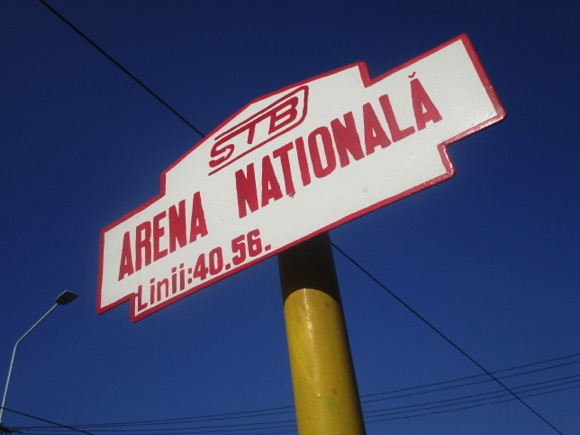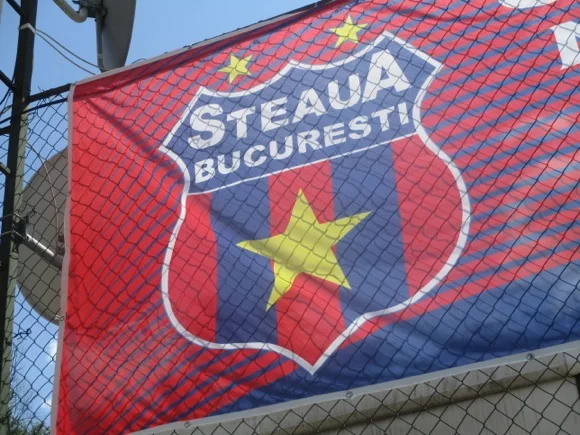Teams, tales and tips – a guide to the local game
Awarded co-hosting rights for Euro 2020, staging the Europa League Final in 2012 and acting as host venue for local clubs in the European competitions, Bucharest’s National Arena has brought the Romanian game back onto the global stage. Until their own ground was rebuilt, the national stadium was also the regular home of the country’s most decorated club, Steaua Bucharest.
This is the new face of the Romanian capital: a modern, EU metropolis still emerging from a dark past.
Behind the scenes though, controversy, dark deeds and corruption still haunt football here – not that Bucharest is alone in such matters. Gigi Becali, notorious owner of Steaua, received a jail sentence for his underhand land deals, illustrating the murky relationships between state bodies and the football clubs who once fronted them.



Steaua represented the army, bitter rivals Dinamo Bucharest the interior ministry. Such is the cloak-and-dagger nature of Romanian society, little may have changed behind the scenes even after the overthrow of brutal Communist dictator Nicolae Ceaușescu in 1989.
European Cup winners in 1986, finalists three years later, Steaua were the first club from the Eastern bloc to attain such heights. Able to attract the best Romanian talent, most notably Gheorghe Hagi, Steaua were the dominant domestic force but relinquished the role after Hagi left for Real Madrid and the Communist system that held them in place collapsed. Dinamo then regained the title they had lost to Steaua earlier in the 1980s.
Under Communism, a victory for Steaua or Dinamo reflected the internal power struggle between army and ministry of the interior, ie the secret police, the omnipotent Securitate. Steaua were favoured by Valentin Ceaușescu, son of dictator Nicolae. Matters came to a head at the notorious, unfinished cup final of 1988, a scandal of bizarre refereeing decisions, mass protests and ugly scenes in front of the VIP balcony – the trophy was never officially awarded.



For nearly three decades, in fact, the Romanian title stayed in the capital every year but one, invariably held by Steaua or Dinamo – the Eternul or Marele (‘Great’) Derby between them took on increased significance. Both clubs had been created with the post-war Communist reconstruction of sport. Before then, Bucharest was a little-known footballing outpost in the Balkans.
At domestic level, Bucharest teams with romantic names such as Venus and Juventus challenged pre-war football powerhouse, Timișoara. Even today, only Steaua and Dinamo have won more titles than Venus, whose ground close to the opera was knocked down after the war.
The last team that Venus pipped for the title, who beat them in the Romanian Cup final that same year of 1940, were Rapid. The capital’s third team in modern times, railway team Rapid emerged from near disappearance to gain promotion back to the top flight in 2014.
Despite finishing in a promotion spot again in 2016, the club was dissolved, then still managed to climb back from the lower leagues. A fan base remained in place as the club moved up to Liga I in 2021, and from its temporary home at Sportul Studențesc back to a rebuilt Giulești in 2022.



Back in the 1940s, a contemporary of Venus and Juventus, Unirea Tricolor, were merged with Ciocanul to create Dinamo. Ciocanul themselves were formerly Maccabi, a Jewish club who didn’t survive the anti-Semitic policies of the war-time government. Dinamo won their first title in 1955 and became the first Romanian club to compete in the European Cup.
By then, Steaua had already been crowned four times, and each rival enjoyed successive title runs, triumph partly depending on political influence.
This state of affairs remained long after 1989. Untainted by ties with the state or the military, Rapid became many neutral’s club of choice in the modern era. A high point came with the all-Romanian UEFA Cup quarter-final of 2006, lost by Rapid on away goals by Steaua.
With the rise of Cluj in Transylvania, the Bucharest stranglehold was broken – albeit temporarily. In 2014, Steaua won their second title in a row.






While Rapid could, perhaps should, have been promoted in 2013, having won the play-off, but top-flight status was awarded to Concordia instead. Based in Chiajna, on Bucharest’s north-western outskirts, Concordia just survived in Liga I in 2013-14. After relegation in 2019, the club now sits comfortably in Liga II.
Romanian Cup winners in 2017, Voluntari represent the burgeoning suburb of the same name just north of Bucharest city limits, towards the airport. With a strong sense of community – ‘Voluntari’ refers to the volunteers of World War I promised plots of land here if they came back alive – this city of 40,000-plus inhabitants has seen money flood in with companies offered cheaper rates than a couple of kilometres away in the capital.
This led to the municipality setting up a professional football team in 2010, which rose up from the local league to the top flight in four straight seasons. For their first campaign in Liga I, Voluntari moved home games to the Dinamo Stadium while their own Anghel Iordănescu was being rebuilt and reconfigured for top-tier football.
Named after the former Steaua player who coached the club and the Romanian national team to untold heights, and was later a member of the Romanian Senate for surrounding Ilfov County, the ground now holds 4,600. A couple of stands with seats in the colours of the Romanian flag surround a simple pitch – this could easily be Liga II.
To reach it, a taxi from Aurel Vlaicu metro station should take 10mins and cost around 12-15 lei/€2.50-€3.
Getting Around
Arriving in town, local transport and timings




Henri Coandă, aka Otopeni, is 17km (11 miles) north-west of town. A signposted door from the Arrivals terminal leads out to the bus stops for town, with a ticket office to the right as you exit. A magnetic card for two trips is 8.60 lei/€1.80 (cash-only), touch in when you board. The 780 runs to the main train station of Gara de Nord, the 783 to Piața Victoriei/Piața Unirii, the 784 to Piața Unirii, roughly every every 30mins-1hr. Timetables are works of fiction. Journey time is around 30-45mins.
From Gara de Nord, the bus stop to the airport is across from the west side, nearest the Hotels Sir and Andy. For a taxi, there are touch screens in Arrivals – press for the next vehicle, you’ll receive a number, a waiting time and a ticket you give to the driver. Expect to pay around 40-50 lei/€8-€10 into town.
For the four-line metro network, it’s 5 lei/€1 for 2 rides, 20 lei/€4 for 10 – and 8 lei/€1.65 for a day pass on bus, trams and trolleybuses as well. For non-metro journeys, buy a Aktiv card (3.70 lei/€0.75) and charge it at €1.30 lei/€2.70 per trip for 2-10 uses. Touch in when you board. Bucharest is chaotic so keep your wits about you when crossing the road – and watch out for stray dogs.
Taxis in Bucharest are a law unto themselves – make sure the meter is switched on. A journey across town should be around 10-15 lei/€2-€3. Taxi Mondial (+40 21 9423) are as good as any and based near the National Arena.
Where to Drink
The best pubs and bars for football fans








A Bermuda Triangle of streets in the historic centre – Strada Șelari, Covaci and Gabroveni – is where you find three dozen drinking spots at least. The most football-focused are Halftime, framed Liverpool shirts displayed around a host of plasma screens, and Mojo, another LFC haunt next door, with equal emphasis on live music. Note the signed Hagi shirt when you walk in.
Also on Gabroveni, Beer O’Clock lines its counter and huge fridge with craft options. The Boulevard Pub and Fire Club on Covaci tick most boxes, offering live TV sports. The Drunken Lords on Șelari knows how to party.
In the same bar hub, True concentrates on live music, while Jack’s Pub is a little more upscale, with regular DJs. The restaurant-like St Patrick treads a more mainstream path.





Across main Bulevardul Brătianu, Légère on Piața Rosetti is more café/restaurant, attracting a mainly Romanian crowd of twenty-to-fiftysomethings out for a good time, with quality beer, decent food and a nice courtyard in warmer weather.
Still central, Ryan’s on Piața Amzei should appeal to all, with a decent kitchen to boot, while The Dubliner (Nicolae Titulescu 18) has been providing homesick Brits and Celts with Guinness and Premiership football since 1995.
Near Universitatea, The Pub Trocadero sticks to the same winning formula as its Czech stablemates, with quality beer and a lively atmosphere. At Piața Unirii, The Harp (Strada Bibescu Vodă) brings in the expat business crowd.
Where to stay
The best hotels for the stadiums and city centre






Bucharest has no credible resource for tourist information or hotel booking. The only hotel within striking distance of the the National Arena is the chain Holiday Inn-Times, behind Piața Muncii metro station on Bulevardul Decebal.
Near Dinamo’s stadium, and thus Ștefan cel Mare metro station on the same line as Piața Muncii, the Graffiti Hotel on Strada Albac comprises lower three-star rooms and a restaurant. Also close, the more business-like Capital Plaza on main Bulevardul Iancu de Hunedoara feels like a four-star, with its own brasserie.
Around the Gara de Nord, handy for the airport and most stadiums, Hello on Calea Griviței serves the budget traveller perfectly, comfortable yet standard, with friendly staff and cheap online rates.
The Continental Group that owns it has just taken over the large ibis next door, revamped and rebranded to be called MyContinental. Again, lower mid-range, affordable, comfortable and convenient. Opposite, the Euro Hotels Gara de Nord is more downbeat.










The main global chains have long set up in the city centre, in landmark buildings such as the Grand, the former InterContinental, with its panoramic gym and pool by Universitate metro station, the palatial Marriott with its high-end spa just behind the vast Parliament building, and the four-star Novotel with its gleaming façade on Calea Victoriei.
Opposite, the Grand Hotel Continental echoes the Belle Époque. Further up the same showcase boulevard, the Athenee Palace, now an InterContinental, was the ornate haunt of spies and newspaper correspondents either side of the war.
Further along the avenue, the Radisson Blu adds a contemporary touch. Behind it, the Park Inn by Radisson brings colour and style to Strada Luterană.
City-centre hotels can also be affordable. The Tania Hotel on Strada Șelari provides convenient comfort in the bar quarter, while the Atrium Ateneu, the former Amzei on the square of the same name, owes its elegant look to its foundation date of 1912.






